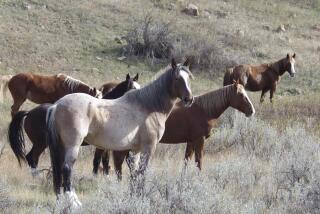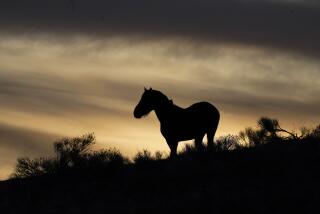Wrangler Rides Range--in Copter : Wild Horses Rounded Up for Federal Adoption Program
- Share via
SUSANVILLE, Calif. — As it was for trailblazers 100 years ago, wrangling is Gene Nunn’s life. Through craggy, unforgiving terrain he patiently leads herds of wild horses down the trails to captivity--only in Nunn’s case, the cowboy tale has a modern twist.
The head wrangler for the Bureau of Land Management’s horse-adoption program in the Northern California counties of Modoc and Lassen and in Nevada’s Washoe County, Nunn handles his roundups from the “shotgun” seat of a helicopter.
From there Nunn spots animals so wild, so free and frightened that they are capable of destroying virtually anything in their paths. From there he directs their herding and capture and their eventual transformation from wild animals to pets through bureau horse adoptions nationwide.
43,000 on Western Ranges
The bureau estimates that there are about 43,000 wild horses on ranges in Oregon, California, Idaho, Utah, Montana, Colorado, New Mexico, Arizona, Wyoming and Nevada, where 30,000 roam.
The federal agency has set a management level of 26,000, meaning that there are about 17,000 too many for the land that must support them. Rather than let them die of starvation on the range, the bureau rounds them up and offers them for adoption.
People 18 and older can obtain the horses for $125 each, burros for $75 apiece.
Not everyone will qualify as an adopter, though. Because the horses are wild, many will be flighty or worse. Bureau officials check the background of applicants, make sure they can provide adequate homes and, in effect, put them on “probation” for a year. If, after that time, it appears the adoption is going well, title to the horse is released.
Some adoptions do not work out. Breaking the horses can be tough. But the program has the strong support of animal protection groups.
“If the alternative is having horses die from starvation out on the range, I think rounding them up and putting them up for adoption is great,” said Tom Claar, an investigator for the Haven Humane Society in Redding, which has a contract with the bureau to investigate alleged cruelty in some adoptions.
A tone in Nunn’s voice does suggest a desire for old-time roundup methods. To be on horseback himself, herding them down trails perhaps he alone knows better than the horses, would only seem right. The respect he holds for those animals that elude him, that test the wrangling know-how compiled over nearly all of Nunn’s 50 years would merely grow stronger.
‘Some Special Ones’
“There have been some special ones out there,” Nunn said. “If you get one that beats you, that keeps getting away, and you’re in a helicopter costing $200 an hour of the taxpayers’ money, you get mad at him in a way. But you respect him, too, for being able to get away.
“The higher the region, the rougher and rockier it is, the better they seem to like it. That’s why we use the helicopter.”
Nunn said the horses are more frightened than anything. “They’re a lot more scared than they are wild,” he said. “That’s why we handle them quietly, move them around slowly.”
But to say they are not wild after they are herded into corral traps would be to understate the case dramatically.
Even after weeks of captivity, the horses can be incorrigible. Said Sacramento resident Marilyn Lamm, who adopted a pair of burros from the program: “One lady who adopted a horse had a brand new trailer when she went to pick it up, and it was practically destroyed by the time the poor woman got out of there.”
“They’re used to sagebrush, a few trees, but not a penned area,” Nunn said. “When you trap them, you’ve taken away their No. 1 defense, which is to run away. So, they’ll be flighty for a while. They’ll try anything. The corral panels are seven feet tall, and we’ve had horses jump them.”
Bait Horse Used
Nunn has herded wild horses up to five miles to a trapped area. This is done with the aid of a bait horse, which is used to lead them into captivity. “We just try to get them pointed in the right direction, let them move at their own pace,” he said.
In Nunn’s district, 250 to 300 horses must be rounded up yearly to stay at the bureau’s maintenance level. “In Modoc we’re down to a maintenance level, so we gather about 60 there. In some areas we might collect 30 head a day for three or four days, then move our trap,” he said.
It is not possible to get down to a maintenance level in a state like Nevada, where more than half of all wild horses are located. “There isn’t enough demand for the horses, or enough funding,” Nunn said.
Once rounded up, horses are freeze-branded, given shots, wormed and aged. Ages are determined by the teeth, an accurate method until horses are about 6 years old, Nunn said.
The adoptions are held just about everywhere, Nunn said, with an emphasis on finding places where there is a lot of horse interest, such as riding clubs.
More to Read
Sign up for Essential California
The most important California stories and recommendations in your inbox every morning.
You may occasionally receive promotional content from the Los Angeles Times.










